Pengyu Liu
A Survey on fMRI-based Brain Decoding for Reconstructing Multimodal Stimuli
Mar 20, 2025
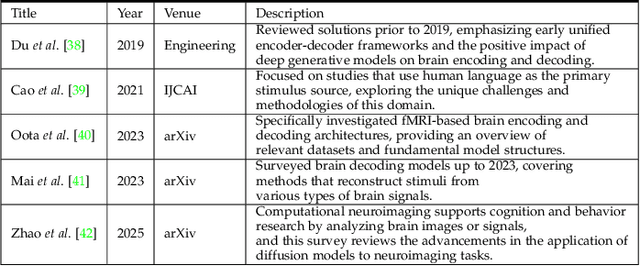
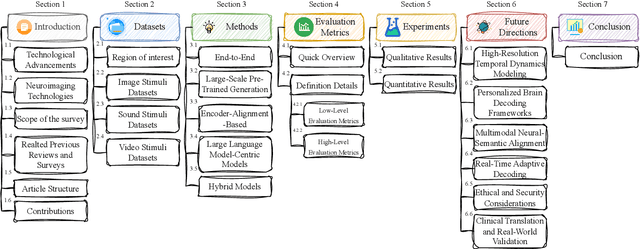
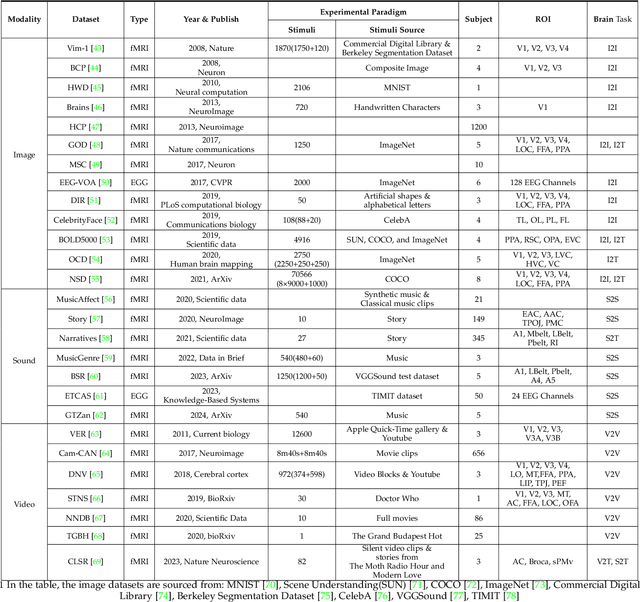
Abstract:In daily life, we encounter diverse external stimuli, such as images, sounds, and videos. As research in multimodal stimuli and neuroscience advances, fMRI-based brain decoding has become a key tool for understanding brain perception and its complex cognitive processes. Decoding brain signals to reconstruct stimuli not only reveals intricate neural mechanisms but also drives progress in AI, disease treatment, and brain-computer interfaces. Recent advancements in neuroimaging and image generation models have significantly improved fMRI-based decoding. While fMRI offers high spatial resolution for precise brain activity mapping, its low temporal resolution and signal noise pose challenges. Meanwhile, techniques like GANs, VAEs, and Diffusion Models have enhanced reconstructed image quality, and multimodal pre-trained models have boosted cross-modal decoding tasks. This survey systematically reviews recent progress in fMRI-based brain decoding, focusing on stimulus reconstruction from passive brain signals. It summarizes datasets, relevant brain regions, and categorizes existing methods by model structure. Additionally, it evaluates model performance and discusses their effectiveness. Finally, it identifies key challenges and proposes future research directions, offering valuable insights for the field. For more information and resources related to this survey, visit https://github.com/LpyNow/BrainDecodingImage.
Timely reliable Bayesian decision-making enabled using memristors
Dec 07, 2024Abstract:Brains perform timely reliable decision-making by Bayes theorem. Bayes theorem quantifies events as probabilities and, through probability rules, renders the decisions. Learning from this, applying Bayes theorem in practical problems can visualize the potential risks and decision confidence, thereby enabling efficient user-scene interactions. However, given the probabilistic nature, implementing Bayes theorem with the conventional deterministic computing can inevitably induce excessive computational cost and decision latency. Herein, we propose a probabilistic computing approach using memristors to implement Bayes theorem. We integrate volatile memristors with Boolean logics and, by exploiting the volatile stochastic switching of the memristors, realize Boolean operations with statistical probabilities and correlations, key for enabling Bayes theorem. To practically demonstrate the effectiveness of our memristor-enabled Bayes theorem approach in user-scene interactions, we design lightweight Bayesian inference and fusion operators using our probabilistic logics and apply the operators in road scene parsing for self-driving, including route planning and obstacle detection. The results show that our operators can achieve reliable decisions at a rate over 2,500 frames per second, outperforming human decision-making and the existing driving assistance systems.
MMAD: Multi-label Micro-Action Detection in Videos
Jul 07, 2024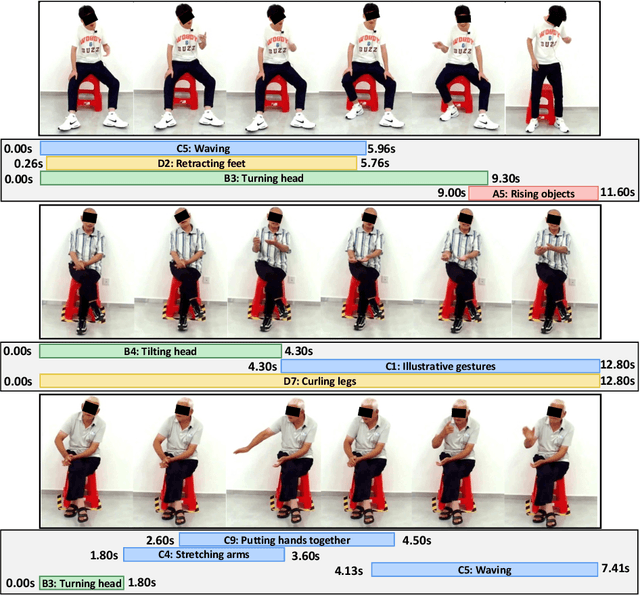



Abstract:Human body actions are an important form of non-verbal communication in social interactions. This paper focuses on a specific subset of body actions known as micro-actions, which are subtle, low-intensity body movements that provide a deeper understanding of inner human feelings. In real-world scenarios, human micro-actions often co-occur, with multiple micro-actions overlapping in time, such as simultaneous head and hand movements. However, current research primarily focuses on recognizing individual micro-actions while overlooking their co-occurring nature. To narrow this gap, we propose a new task named Multi-label Micro-Action Detection (MMAD), which involves identifying all micro-actions in a given short video, determining their start and end times, and categorizing them. Achieving this requires a model capable of accurately capturing both long-term and short-term action relationships to locate and classify multiple micro-actions. To support the MMAD task, we introduce a new dataset named Multi-label Micro-Action-52 (MMA-52), specifically designed to facilitate the detailed analysis and exploration of complex human micro-actions. The proposed MMA-52 dataset is available at: https://github.com/VUT-HFUT/Micro-Action.
Micro-gesture Online Recognition using Learnable Query Points
Jul 05, 2024Abstract:In this paper, we briefly introduce the solution developed by our team, HFUT-VUT, for the Micro-gesture Online Recognition track in the MiGA challenge at IJCAI 2024. The Micro-gesture Online Recognition task involves identifying the category and locating the start and end times of micro-gestures in video clips. Compared to the typical Temporal Action Detection task, the Micro-gesture Online Recognition task focuses more on distinguishing between micro-gestures and pinpointing the start and end times of actions. Our solution ranks 2nd in the Micro-gesture Online Recognition track.
Local stochastic computing using memristor-enabled stochastic logics
Feb 25, 2024Abstract:Stochastic computing offers a probabilistic approach to address challenges posed by problems with uncertainty and noise in various fields, particularly machine learning. The realization of stochastic computing, however, faces the limitation of developing reliable stochastic logics. Here, we present stochastic logics development using memristors. Specifically, we integrate memristors into logic circuits to design the stochastic logics, wherein the inherent stochasticity in memristor switching is harnessed to enable stochastic number encoding and processing with well-regulated probabilities and correlations. As a practical application of the stochastic logics, we design a compact stochastic Roberts cross operator for edge detection. Remarkably, the operator demonstrates exceptional contour and texture extractions, even in the presence of 50% noise, and owning to the probabilistic nature and compact design, the operator can consume 95% less computational costs required by conventional binary computing. The results underscore the great potential of our stochastic computing approach as a lightweight local solution to machine learning challenges in autonomous driving, virtual reality, medical diagnosis, industrial automation, and beyond.
DGR: Tackling Drifted and Correlated Noise in Quantum Error Correction via Decoding Graph Re-weighting
Dec 07, 2023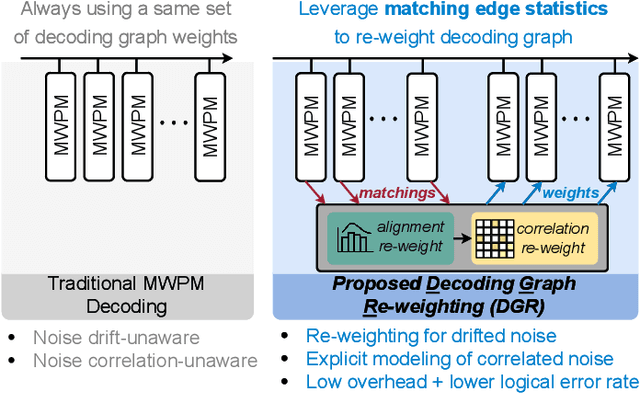
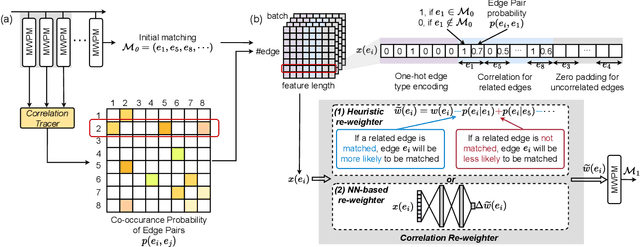


Abstract:Quantum hardware suffers from high error rates and noise, which makes directly running applications on them ineffective. Quantum Error Correction (QEC) is a critical technique towards fault tolerance which encodes the quantum information distributively in multiple data qubits and uses syndrome qubits to check parity. Minimum-Weight-Perfect-Matching (MWPM) is a popular QEC decoder that takes the syndromes as input and finds the matchings between syndromes that infer the errors. However, there are two paramount challenges for MWPM decoders. First, as noise in real quantum systems can drift over time, there is a potential misalignment with the decoding graph's initial weights, leading to a severe performance degradation in the logical error rates. Second, while the MWPM decoder addresses independent errors, it falls short when encountering correlated errors typical on real hardware, such as those in the 2Q depolarizing channel. We propose DGR, an efficient decoding graph edge re-weighting strategy with no quantum overhead. It leverages the insight that the statistics of matchings across decoding iterations offer rich information about errors on real quantum hardware. By counting the occurrences of edges and edge pairs in decoded matchings, we can statistically estimate the up-to-date probabilities of each edge and the correlations between them. The reweighting process includes two vital steps: alignment re-weighting and correlation re-weighting. The former updates the MWPM weights based on statistics to align with actual noise, and the latter adjusts the weight considering edge correlations. Extensive evaluations on surface code and honeycomb code under various settings show that DGR reduces the logical error rate by 3.6x on average-case noise mismatch with exceeding 5000x improvement under worst-case mismatch.
RobustState: Boosting Fidelity of Quantum State Preparation via Noise-Aware Variational Training
Nov 27, 2023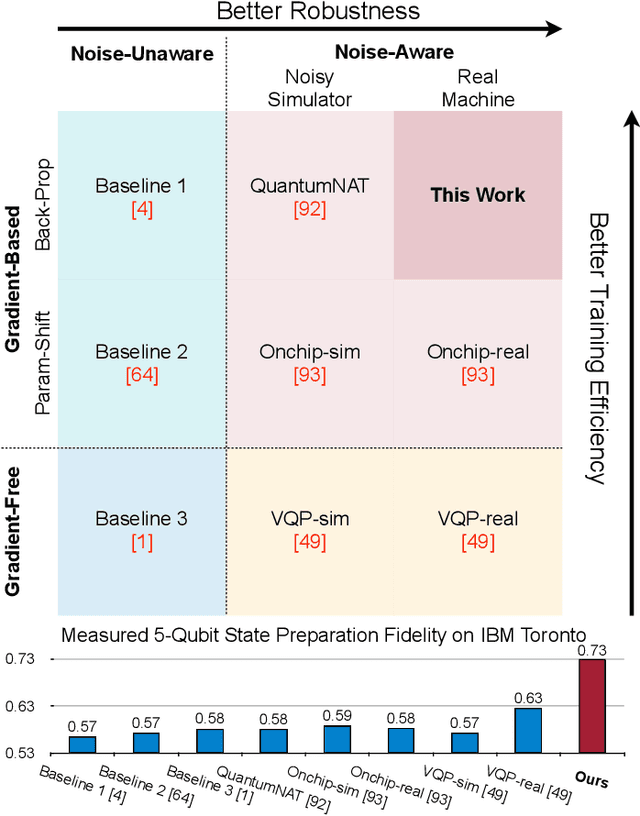
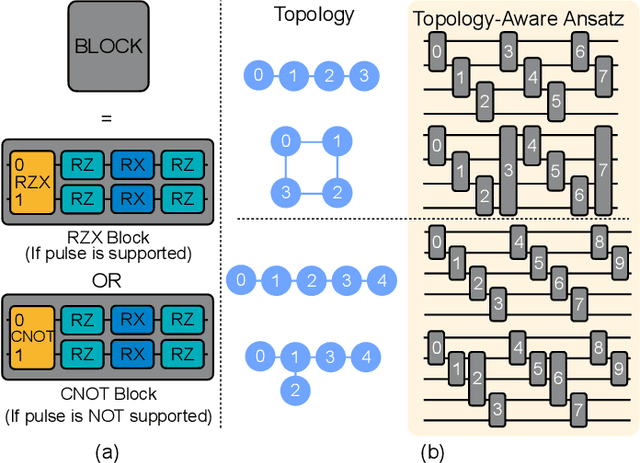
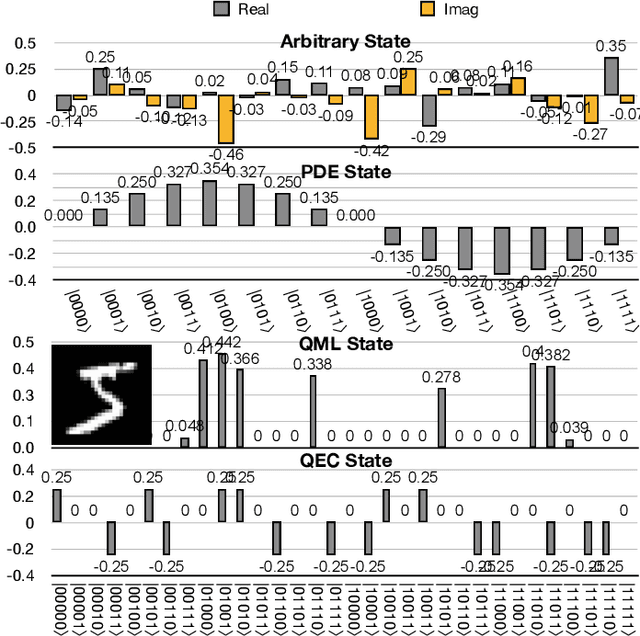
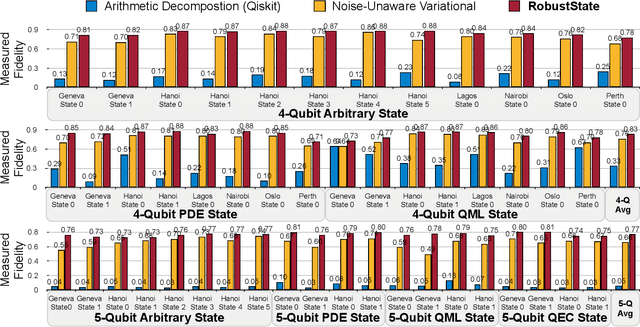
Abstract:Quantum state preparation, a crucial subroutine in quantum computing, involves generating a target quantum state from initialized qubits. Arbitrary state preparation algorithms can be broadly categorized into arithmetic decomposition (AD) and variational quantum state preparation (VQSP). AD employs a predefined procedure to decompose the target state into a series of gates, whereas VQSP iteratively tunes ansatz parameters to approximate target state. VQSP is particularly apt for Noisy-Intermediate Scale Quantum (NISQ) machines due to its shorter circuits. However, achieving noise-robust parameter optimization still remains challenging. We present RobustState, a novel VQSP training methodology that combines high robustness with high training efficiency. The core idea involves utilizing measurement outcomes from real machines to perform back-propagation through classical simulators, thus incorporating real quantum noise into gradient calculations. RobustState serves as a versatile, plug-and-play technique applicable for training parameters from scratch or fine-tuning existing parameters to enhance fidelity on target machines. It is adaptable to various ansatzes at both gate and pulse levels and can even benefit other variational algorithms, such as variational unitary synthesis. Comprehensive evaluation of RobustState on state preparation tasks for 4 distinct quantum algorithms using 10 real quantum machines demonstrates a coherent error reduction of up to 7.1 $\times$ and state fidelity improvement of up to 96\% and 81\% for 4-Q and 5-Q states, respectively. On average, RobustState improves fidelity by 50\% and 72\% for 4-Q and 5-Q states compared to baseline approaches.
Transformer-QEC: Quantum Error Correction Code Decoding with Transferable Transformers
Nov 27, 2023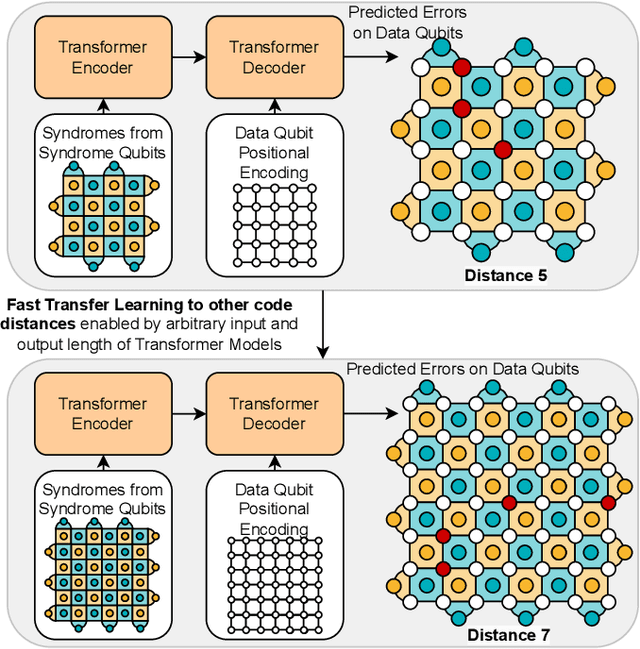
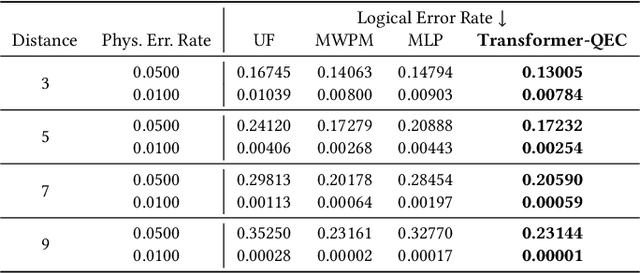


Abstract:Quantum computing has the potential to solve problems that are intractable for classical systems, yet the high error rates in contemporary quantum devices often exceed tolerable limits for useful algorithm execution. Quantum Error Correction (QEC) mitigates this by employing redundancy, distributing quantum information across multiple data qubits and utilizing syndrome qubits to monitor their states for errors. The syndromes are subsequently interpreted by a decoding algorithm to identify and correct errors in the data qubits. This task is complex due to the multiplicity of error sources affecting both data and syndrome qubits as well as syndrome extraction operations. Additionally, identical syndromes can emanate from different error sources, necessitating a decoding algorithm that evaluates syndromes collectively. Although machine learning (ML) decoders such as multi-layer perceptrons (MLPs) and convolutional neural networks (CNNs) have been proposed, they often focus on local syndrome regions and require retraining when adjusting for different code distances. We introduce a transformer-based QEC decoder which employs self-attention to achieve a global receptive field across all input syndromes. It incorporates a mixed loss training approach, combining both local physical error and global parity label losses. Moreover, the transformer architecture's inherent adaptability to variable-length inputs allows for efficient transfer learning, enabling the decoder to adapt to varying code distances without retraining. Evaluation on six code distances and ten different error configurations demonstrates that our model consistently outperforms non-ML decoders, such as Union Find (UF) and Minimum Weight Perfect Matching (MWPM), and other ML decoders, thereby achieving best logical error rates. Moreover, the transfer learning can save over 10x of training cost.
Quantifying syntax similarity with a polynomial representation of dependency trees
Nov 13, 2022Abstract:We introduce a graph polynomial that distinguishes tree structures to represent dependency grammar and a measure based on the polynomial representation to quantify syntax similarity. The polynomial encodes accurate and comprehensive information about the dependency structure and dependency relations of words in a sentence. We apply the polynomial-based methods to analyze sentences in the Parallel Universal Dependencies treebanks. Specifically, we compare the syntax of sentences and their translations in different languages, and we perform a syntactic typology study of available languages in the Parallel Universal Dependencies treebanks. We also demonstrate and discuss the potential of the methods in measuring syntax diversity of corpora.
QuEst: Graph Transformer for Quantum Circuit Reliability Estimation
Oct 30, 2022Abstract:Among different quantum algorithms, PQC for QML show promises on near-term devices. To facilitate the QML and PQC research, a recent python library called TorchQuantum has been released. It can construct, simulate, and train PQC for machine learning tasks with high speed and convenient debugging supports. Besides quantum for ML, we want to raise the community's attention on the reversed direction: ML for quantum. Specifically, the TorchQuantum library also supports using data-driven ML models to solve problems in quantum system research, such as predicting the impact of quantum noise on circuit fidelity and improving the quantum circuit compilation efficiency. This paper presents a case study of the ML for quantum part. Since estimating the noise impact on circuit reliability is an essential step toward understanding and mitigating noise, we propose to leverage classical ML to predict noise impact on circuit fidelity. Inspired by the natural graph representation of quantum circuits, we propose to leverage a graph transformer model to predict the noisy circuit fidelity. We firstly collect a large dataset with a variety of quantum circuits and obtain their fidelity on noisy simulators and real machines. Then we embed each circuit into a graph with gate and noise properties as node features, and adopt a graph transformer to predict the fidelity. Evaluated on 5 thousand random and algorithm circuits, the graph transformer predictor can provide accurate fidelity estimation with RMSE error 0.04 and outperform a simple neural network-based model by 0.02 on average. It can achieve 0.99 and 0.95 R$^2$ scores for random and algorithm circuits, respectively. Compared with circuit simulators, the predictor has over 200X speedup for estimating the fidelity.
 Add to Chrome
Add to Chrome Add to Firefox
Add to Firefox Add to Edge
Add to Edge